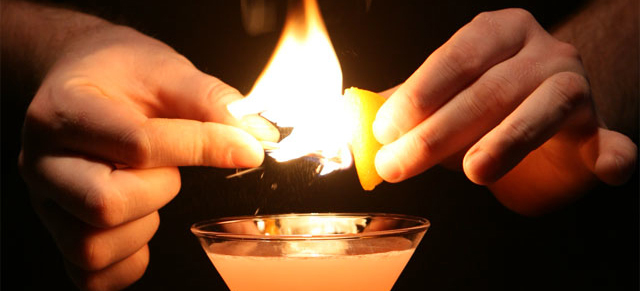Utlizing ‘AI’ Artificial Intelligence Software in the Hospitality Industry
Have you ever wanted more time and more help in your...

This thing called Molecular Mixology
by Richie Cruz
Last weekend was a totally interesting weekend for Philippine Bartending. At N20 Gastropub we held the first Molecular Mixology Workshop conducted by no other then our very own Liquid Chef Neil Ocampo who currently works at 1 Altitude Bar in Singapore.
This 2 day workshop was attended by bartenders and business owners a like but everyone had one goal and that was to learn and embrace this new concept in the beverage industry.
It started out with a lecture and demonstration of the different concepts that comes with Molecular Mixology.
 So what is Molecular Mixology? Molecular Mixology was derived or was like a offshoot of Molecular Gastronomy or molecular cuisine is the science of cooking but it is commonly used to describe a new style of cuisine in which chefs explore new culinary possibilities in the kitchen by embracing sensory and food science, borrowing tools from the science lab and ingredients from the food industry and concocting surprise after surprise for their diners. Formally, the term molecular gastronomy refers to the scientific discipline that studies the physical and chemical processes that occur while cooking. Molecular gastronomy seeks to investigate and explain the chemical reasons behind the transformation of ingredients, as well as the social, artistic and technical components of culinary and gastronomic phenomena in general. The term Molecular Gastronomy was born in 1992 (complete history on this post: Molecular Gastronomy History).
So what is Molecular Mixology? Molecular Mixology was derived or was like a offshoot of Molecular Gastronomy or molecular cuisine is the science of cooking but it is commonly used to describe a new style of cuisine in which chefs explore new culinary possibilities in the kitchen by embracing sensory and food science, borrowing tools from the science lab and ingredients from the food industry and concocting surprise after surprise for their diners. Formally, the term molecular gastronomy refers to the scientific discipline that studies the physical and chemical processes that occur while cooking. Molecular gastronomy seeks to investigate and explain the chemical reasons behind the transformation of ingredients, as well as the social, artistic and technical components of culinary and gastronomic phenomena in general. The term Molecular Gastronomy was born in 1992 (complete history on this post: Molecular Gastronomy History).
Chef Ferran Adria from the famous El Bulli restaurant is one of the credited proponents of this concept.
If you attended this workshop you would think you were in a kitchen laboratory. Think of it this way, liquid nitrogen, powders in canisters, mixing bowls, liquors, syrups, eggs, hand mixers, wire whisks, smoking gun, dry ice, and the list of items goes on.
In the lecture part several concepts comprise molecular cuisine and this includes:
SPHERIFICATION is a spectacular cooking technique they introduced at elBulli in 2003 which enable us to prepare recipes that no one been imagined before. It consists of the controlled gelification of a liquid which, submerged in a bath, form a spheres. There are two kinds of BASIC SPHERIFICATION (which consist of submerging a Liquid with ALGIN in a bath of CALCIC) and REVERSE SPHERIFICATION (submerging a Liquid with GLUCO in a bath of ALGIN)
EMULSIFICATION
In this concept, LECITE is the major component
A natural soy lecithin-based emulsifier, ideal for making airs. This product, discovered at the end of the 19th century, was first produced for the food industry in the last century.
It is useful in the prevention of arteriosclerosis and contains vitamins, minerals and antioxidants.
LECITE is made from non-trasgenic soy.
GELIFICATION
Gelatins are one of the most characteristics preparations in classical cuisine, and they have undergone greater evolution in modern cooking.
Until a few years ago, they were made mainly with gelatin sheets; starting in 1997, AGAR, a product of algae, was introduced and is now commonly used.
LIQUID NITROGEN
Nitrogen is a natural gas. It can be liquified in a plant and is used as such in molecular gastronomy most often to deep freeze foam pieces or to make ice cream.
Origin
The air we breathe is composed of approximately 78% nitrogen in it’s gaseous state, against 21% oxygen and 1% of various other gases. To produce liquid nitrogen, the air is first liquefied and the nitrogen is then separated by distillation. Since the boiling point of nitrogen is -195.8°C (-320.5°F), liquid nitrogen is extremely cold, it’s a liquid said to be “cryogenic
In cooking, liquid nitrogen is used as a coolant. It is not an ingredient and so it is never ingested; it cools the food, then evaporates. It is only after complete evaporation of the liquid nitrogen that the food can be ingested. Foods that are cooled with liquid nitrogen are extremely cold as they have been in contact with this cryogenic substance, and should be left to warm up before being touched and ingested, in the same way that foods dipped in boiling oil must cool down before being touched. The denser the food, the colder it will be and therefore the longer it will need to warm up. This is why chefs typically use liquid nitrogen to make meringues or frozen mousse, that is to say, they dip very low density confections.
Some chefs use the cooling properties of liquid nitrogen to make especially unctuous ice creams. The creaminess of the ice cream is obtained thanks to the small size of the ice crystals formed during cooling with liquid nitrogen. It is also possible to create amazing appetizers like frozen meringue or mousse. Liquid nitrogen finally makes it possible to freeze alcohol to make original cocktails, which is not possible with traditional freezing techniques
Dry Ice – sometimes referred to as “cardice” or as “card ice” (chiefly British English), is the solid form of carbon dioxide. It is used primarily as a cooling agent. Its advantages include lower temperature than that of water ice and not leaving any residue (other than incidental frost from moisture in the atmosphere). It is useful for preserving frozen foods, ice cream, etc., where l Mechanical cooling is unavailable.
Dry ice sublimates at −78.5 °C (−109.3 °F) at Earth atmospheric pressures. This extreme cold makes the solid dangerous to handle without protection due to burns caused by freezing.
SMOKE MACHINE / POLYSCIENCE is inventing culinary technology that helps chefs to find new ways of expressing their creativity. Today, the world’s best chefs rely on this technique. Smoke Machine® thermal circulators are their first choice technology for it and many great friendships have developed since then. His passion for futuristic kitchen gear has also captured the attention of America’s top chefs, like Grant Achatz at Chicago’s Alinea. With the impulse of Chef Achatz, Philip developed the Anti-Griddle™. Within the last years additional innovative culinary tools were added and Philip Preston is constantly working on new inventions to give chefs more ways of expressing their culinary creativity.
The second day was all hands on where in we were tasked to make our own molecular cocktails. I was able to make a creation using dry ice and liquid nitrogen. I tried combining a single malt plus chocolate syrup with liquid nitrogen until I was able to obtain an ice cream consistency. I then tried using the cream charger and made my version of an emulsified raspberry mojito.
The possibilities are endless. It does entail an investment but at the end of the day it’s all about one’s passion in creating that perfect drink.
So the next time you go to bar and order a Bacardi and Coke, don’t be surprised if you are served with a brown pasta plate with lime wedge.
Cheers!
Have you ever wanted more time and more help in your...
MANGO MAGIC: Marco Estrada, Brownsville, TX 1 ½ oz Aviation Gin ¾...
ALOE WOK: Olya Sabanina, Saint Petersburg, Russia 1 1/3 oz Aviation Gin...
We have all strived to become better at our craft, or else,...
About the author, Elton Marvin Jr. has worked in the food and...
From starting out picking up a Flairco bottle after watching the movie...

Your cart is empty.
Click “Play” on the video above.
Click “Play” on the video above.
Click “Play” on the video above.


mixinbtch
January 5, 2014 at 7:19 am